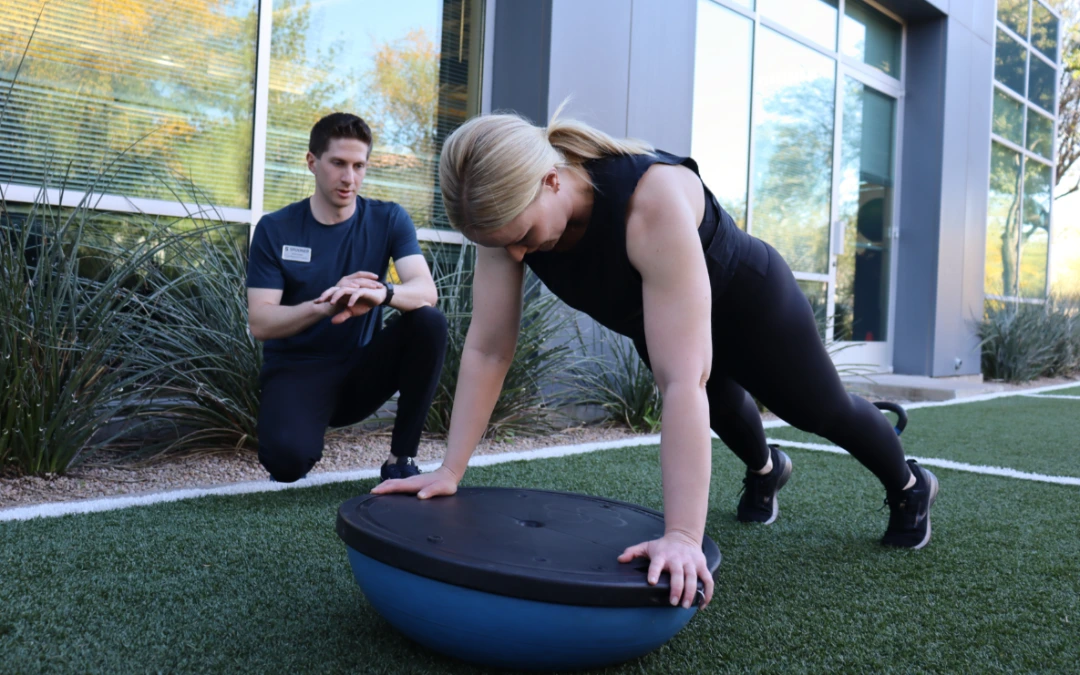I believe we as movement professionals (therapists, personal trainers, coaches, etc.), are drawn to witnessing transformation. Perhaps that’s an athlete we have worked with from their youth into adulthood or coaching someone through new habits to achieve goals towards their body composition, or someone going from being in a state of movement dysfunction, to function. As a personal trainer (what we at Spooner refer to as a FIT Trainer), working alongside physical and occupational therapists, we are fortunate to be a part of a client or patients journey of transformation- from pre-surgery, to post-surgery, and finally to post-graduation from therapy, or all of the above.
Prehab
A FIT Trainer may actually work with a client as part of a preventative plan before a scheduled procedure, as there is evidence to suggest it can improve the client’s ability to rebound and progress in therapy, depending on their diagnosis and other factors1,2,3. We like to call this “prehab” because it is done prior to starting their formal post-operative rehabilitative journey. In fact, often times we can help identify what biomechanical stress is causing the need for surgery in the first place. If an individual is having a knee surgery that can be linked to poor foot or hip function, improving function in those areas not only gives them more success to work off of when they start therapy after surgery, but can help keep that repaired area healthy because we have helped treat what caused it in the first place.
Additionally, while one area of the body is recovering from a procedure, another part of the body has to pick up the slack (think if you injure your right hand and can’t use it, you have to rely on your left a lot more than you usually would!). Making sure the reciprocating or supporting body parts that are going to be working a little harder are prepared for the additional strain can make a big difference in daily function.
Learn how Prehab can benefit you in “Prehab: Why You Should Seek Physical Therapy Before Surgery“
Training During Physical Therapy
As just one example, with my personal background in golf instruction, many of our therapists will approach me for specific questions about a golfer they are treating or may pull me into an evaluation to get advanced analysis on their swing. Concurrently, I may have a client with a dysfunction or symptom that requires a more advanced medical diagnosis or intervention, where the PT’s can step in and help direct care.
Our FIT Trainers have their areas of expertise that can provide benefit to the PT’s, just as they do for us. This symbiotic relationship not only helps us as professionals grow because we learn from each other but is ultimately a substantial benefit to the patient/client as they get an infusion of knowledge and expertise into their experience.
Additionally, a patient may be in therapy for a specific impairment or condition but still have other movement goals they are striving for. An athlete may be in therapy after knee surgery but strive to maintain or improve their upper body strength. While the therapist focuses on the knee during therapy sessions, the FIT Trainer may work with the athlete on non-therapy days to provide upper body strength workouts while programming around the recovery of the knee. This way, the athlete can stay on track to get back to performing their sport.
Training Post- Physical Therapy
Many of our clients are near the end of their therapy efforts or have been successfully discharged and want to keep themselves healthy. For these patients looking to transition to working with a FIT Trainer, we will often have a conversation with the primary therapist, review the therapy notes/supplemental documentation, and go into our initial consultation with the client with a healthy head-start of knowledge of the client’s story, successes, challenges, and goals.
FIT Trainers can also provide exercise programming for clients as they look to building or improving a gym program, or periodized training towards a specific goal. Using our Spooner FIT App from Google Play or AppStore, we have the tools to build and guide clients through those programs whether they are actively with us in the clinic or not.
A Program Unique to You
We believe that success begets success. While prescribing exercise for a client, a FIT Trainer will often incorporate some exercises a client already knows and excels at either from their therapy experience or exercises they have done in the past. From there, new stimuli are introduced via new movements, loads, rates, durations, sequencing, energy demands…the opportunities are endless. Movement is indeed medicine, but it should be a celebration of what your body can do instead of highlighting what it can’t and bring a level of positive emotional stimulation with it.
Schedule a session with a Spooner FIT Trainer at every stage of your movement journey!
References:
- Jahic D, Omerovic D, Tanovic AT, Dzankovic F, Campara MT. The Effect of Prehabilitation on Postoperative Outcome in Patients Following Primary Total Knee Arthroplasty. Med Arch. 2018 Dec;72(6):439-443. doi: 10.5455/medarh.2018.72.439-443. PMID: 30814777; PMCID: PMC6340623. https://pubmed.ncbi.nlm.nih.gov/30814777/
- Moyer, Rebecca PT, PhD1,a; Ikert, Kathy PT2; Long, Kristin PT3; Marsh, Jacquelyn PhD4. The Value of Preoperative Exercise and Education for Patients Undergoing Total Hip and Knee Arthroplasty: A Systematic Review and Meta-Analysis. JBJS Reviews 5(12):p e2, December 2017. | DOI: 10.2106/JBJS.RVW.17.00015. https://pubmed.ncbi.nlm.nih.gov/29232265/
- Yang, Ajax; Sokolof, Jonas; Gulati, Amitabh. The effect of preoperative exercise on upper extremity recovery following breast cancer surgery: a systematic review. International Journal of Rehabilitation Research 41(3):p 189-196, September 2018. | DOI: 10.1097/MRR.0000000000000288. https://pubmed.ncbi.nlm.nih.gov/29683834/

